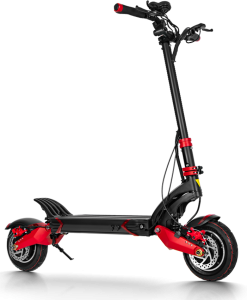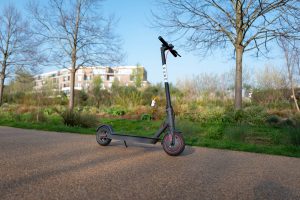When buying an electric scooter, prioritize range, battery life, power, build quality, and comfort.
Range and Battery Life
When shopping for an electric scooter, understanding the range and battery life is critical to ensuring that the scooter meets your commuting needs. These aspects determine how far you can travel on a single charge and how often you’ll need to recharge the battery, directly affecting the scooter’s convenience and operational cost.
Estimating Your Daily Commute
To decide on the range you need, calculate the total distance of your daily commute to work, school, or other frequent destinations. If your round trip is 10 miles and you have charging facilities at your destination, a scooter with a 15-mile range could suffice. However, it’s wise to opt for a scooter with a range 20-30% greater than your longest regular trip to accommodate for battery degradation over time, unexpected detours, or additional errands.
Battery Types and Lifespan
Electric scooters typically use one of two battery types: sealed lead-acid (SLA) or lithium-ion. Lithium-ion batteries are prevalent in newer models due to their lighter weight, longer lifespan, and better performance. They can last for 500 to 1000 charge cycles before dropping to 80% efficiency. For a battery with a lifespan of 1000 cycles, if you charge it every day, you can expect it to maintain optimal performance for roughly 3 years.
Charging Time Considerations
Charging time is a crucial factor if you need to use the scooter multiple times a day. Average charging times can range from 3 to 8 hours. If quick turnaround is essential for you, look for models that offer fast-charging capabilities. Some high-end scooters can charge to 70% in less than an hour, ensuring you’re not tethered to a power outlet for long. Remember that frequent fast charging may reduce the overall lifespan of the battery, so consider this trade-off when making your decision.
When assessing battery life, consider factors like:
- Power rating: A battery’s power rating, measured in watt-hours (Wh), indicates its energy capacity. A higher Wh rating usually translates to a longer range.
- Cost: The initial price of an electric scooter with a high-quality battery can be significant, but this often correlates with longer lifespan and better performance, resulting in lower long-term costs.
- Efficiency: Battery efficiency can decrease over time and with usage. High-quality batteries maintain efficiency longer, providing sustained range and performance.
- Maintenance fees: Lithium-ion batteries typically require less maintenance than SLA batteries, which can impact the overall budget for your scooter.
- Value: A scooter with a reliable battery maintains its value better and may have higher resale value.
- Charging time: A battery’s capacity and the scooter’s charger specifications will determine how long it takes to charge. This can vary, so select a scooter that fits into your schedule and lifestyle.
Motor Power and Performance
Choosing the right electric scooter involves closely examining the motor power and performance. These factors not only influence the overall speed and acceleration but also how well the scooter handles various terrains and slopes.
Understanding Motor Specifications
Motor power, typically measured in watts, directly impacts an electric scooter’s ability to accelerate and maintain speed. Motors can range from 250 watts for basic models, suitable for flat terrains and lighter riders, up to 5000 watts for high-end models designed for off-road use and heavier loads. A 500-watt motor is a good middle-ground for most users, providing a balance between speed and energy consumption. It’s essential to match the motor’s power with your intended use; a higher wattage motor will increase the scooter’s capabilities but also its cost and possibly its weight.
Terrain and Climbing Angles
For riders who live in hilly areas or plan to ride over diverse terrains, the climbing angle, which the motor power influences, is a critical specification. A motor with at least 350 watts can handle inclines up to 10 degrees efficiently. However, for steeper inclines, you may require a motor with 500 watts or more. Always check the scooter’s specified maximum climbing angle, and compare it with the inclines you plan to navigate.
Top Speed and Acceleration Needs
Top speed is a crucial aspect of performance, with most scooters capable of reaching speeds between 15 to 25 miles per hour. However, for individuals looking for high-performance scooters, some models can exceed 50 miles per hour. Keep in mind local regulations may restrict the use of high-speed electric scooters on public roads.
Acceleration is equally important, especially in urban environments where you may need to speed up quickly. A scooter with a higher torque motor will have better acceleration. However, this can also reduce the scooter’s range due to increased power consumption.
When evaluating motor specifications, here are some numbers to consider:
- Power: Look for a minimum of 250 watts for light commuting, but aim for 500 watts if you anticipate hills or heavier loads.
- Price: Motor power correlates with cost; higher-powered motors typically come with a higher price tag.
- Efficiency: A more powerful motor might not always be more efficient. Balance between power and battery consumption is vital to ensure a practical range.
- Speed: Regulations often limit the maximum speed of electric scooters to around 15-20 mph for safety reasons, but some can reach up to 50 mph or more.
- Climbing ability: Assess the grade of inclines you will encounter and ensure the motor can handle at least a 10-degree incline for basic commuting needs.
- Acceleration: Stronger motors will provide quicker acceleration, an advantage in stop-and-go traffic conditions.
Comfort and Ride Quality
An electric scooter’s comfort and ride quality are pivotal to the overall experience, especially if you plan to use it frequently or for long distances. These factors are greatly influenced by the scooter’s suspension system, wheel size, deck ergonomics, and handlebar design.
Suspension and Wheel Size
Suspension systems on electric scooters come in various designs, such as spring, hydraulic, or air piston, and they contribute significantly to the smoothness of the ride. A well-designed suspension can absorb bumps and shocks, providing comfort even on rough terrains. For urban environments with well-maintained roads, a basic suspension may suffice, but for more challenging surfaces, a more advanced suspension system will be necessary.
Wheel size also plays a crucial role in ride comfort. Larger wheels, generally around 10 inches in diameter, can navigate potholes and road imperfections more smoothly than smaller wheels. They also provide a higher top speed due to their larger circumference, but this can sometimes come at the expense of increased weight and a slight reduction in acceleration.
Deck Size and Material
The size of the scooter’s deck affects how comfortably you can stand on it. A larger deck provides more space to adjust your foot position on long rides, reducing fatigue. The material of the deck influences its grip and durability. Most decks are made of aluminum for strength and lightweight, often covered with a rubber or silicone mat for better traction.
Handlebar Design and Ergonomics
Handlebars should be at a comfortable height relative to the rider’s standing position to avoid strain on the back and shoulders. Adjustable handlebars can accommodate riders of different heights, which is an excellent feature if multiple people will use the scooter. The grip material should provide comfort and control, with textures or patterns that minimize slippage even when your hands are wet.
When you evaluate the comfort and ride quality of an electric scooter, consider the following specifics:
- Suspension: Opt for a scooter with adjustable suspension settings to tailor the ride comfort to your preference.
- Wheel Size: 8-inch wheels are standard for light, compact scooters, but choose 10 inches or larger for better stability and comfort.
- Deck Dimensions: Look for a deck that’s at least 5 inches wide and 14 inches long for ample foot space.
- Material Quality: High-quality materials like aerospace-grade aluminum can offer a good balance between durability and weight.
- Handlebar Height and Ergonomics: Adjustable handlebars are preferable, and they should allow your arms to rest in a natural position.
Remember, the overall quality of the ride is just as important as the scooter’s technical specifications. A comfortable scooter makes the ride enjoyable and ensures that you can use it for longer periods without discomfort.
Build Quality and Durability
The longevity of an electric scooter is directly linked to its build quality and durability. These aspects are defined by the materials used, the design of the frame, the scooter’s capacity to carry weight, and its ability to withstand different weather conditions.
Frame Materials and Design
The frame is the backbone of an electric scooter, providing the necessary support and stability. Manufacturers often use aluminum or steel for frames. Aluminum is lightweight and resistant to corrosion, making it a popular choice for its balance of strength and portability. Advanced models might employ carbon fiber or titanium, which are lighter and stronger but also come at a higher price point.
The design of the frame also contributes to the scooter’s overall durability. A well-designed frame distributes weight evenly and can withstand the stress of regular use without warping or bending. Reinforced welding at joints and a thicker gauge in high-stress areas are indicators of a robust design.
Weight Capacity and Scooter Weight
Weight capacity is a critical specification, as it determines who can safely ride the scooter and what additional loads it can carry. Most scooters support up to 220 pounds, but some are built to handle up to 300 pounds or more. The weight of the scooter itself also affects its portability and performance. Lightweight scooters are easier to carry and maneuver but may sacrifice some durability. Conversely, heavier scooters can offer a sturdier ride.
Weatherproofing and IP Ratings
To ensure a scooter’s longevity, it must have some degree of weatherproofing. The Ingress Protection (IP) rating system defines a scooter’s level of resistance to dust and water. For example, a scooter with an IP54 rating is protected against limited dust ingress and splashing water from any direction. Higher IP ratings, such as IP65 or above, indicate a higher level of protection, which is essential for riders in areas with frequent rain.
When considering the build quality and durability of an electric scooter, pay attention to:
- Frame Material: Aerospace-grade aluminum is common for its durability and lightweight, while carbon fiber is top-tier for high-end models.
- Weight Limits: Ensure the scooter can support your weight plus any cargo without straining the frame.
- Scooter’s Own Weight: Lightweight models may weigh around 15 pounds, whereas more durable models can weigh 30 pounds or more.
- Weather Resistance: Look for an appropriate IP rating for your climate. IP54 offers basic protection, but IP65 or higher is recommended for wet weather conditions.
Selecting a scooter with a robust build quality will increase its lifespan and provide a more reliable mode of transportation. This could mean higher upfront costs, but the investment pays off in the long term with fewer repairs and replacements needed.



